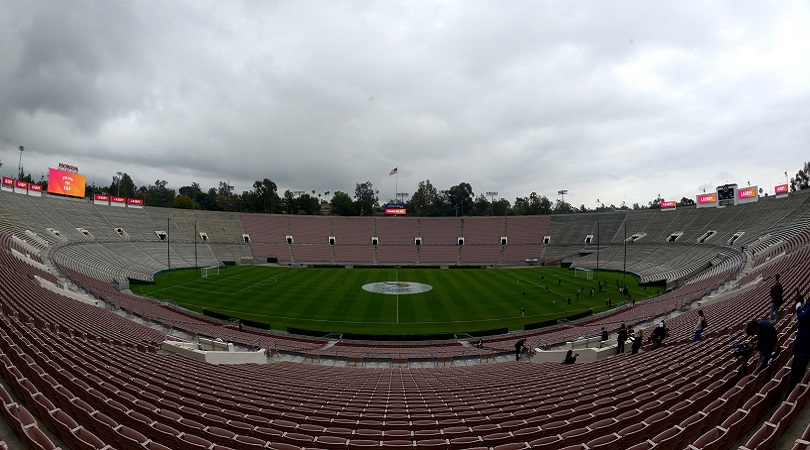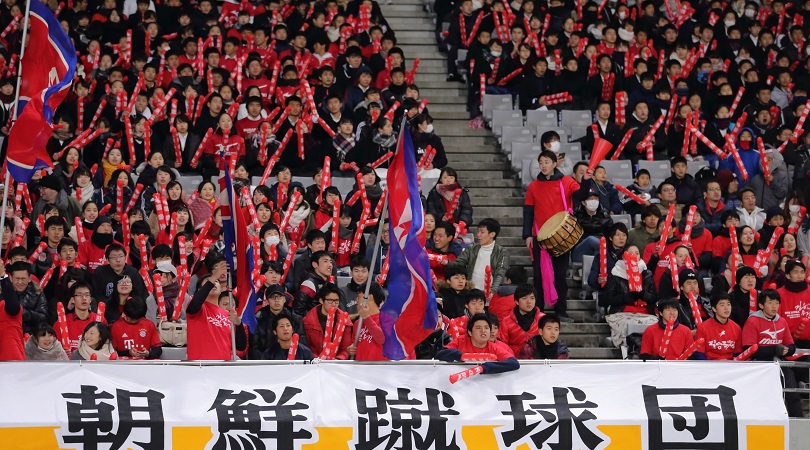The 20 biggest football stadiums in the world

World's biggest stadiums
The 2018 World Cup Final takes place at the Luzhniki Stadium in Moscow on Sunday, with the recently renovated arena now one of the 20 biggest football stadiums on the planet. But which other grounds also make the cut? Read on to find out…

20. Beijing National Stadium (80,000)
An extra 12 seats makes the Guangdong Olympic Stadium larger than the Beijing National Stadium, but the former is so rarely used for football that it’s not worthy of inclusion here. The capital’s 80,000-seater arena – which is nicknamed the Bird’s Nest – was built for the 2008 Olympics and has, rather more bizarrely, hosted three Italian Super Cup matches in the years since.
Birmingham City have also played in the stadium, beating Beijing Guoan 1-0 during their tour of China in 2010, while Arsenal and Chelsea locked horns here in a 2017 friendly.

19. FedEXField (80,000)
Home to NFL side Washington Redskins since it was opened in 1997, FedExField has also hosted numerous football matches in the last two decades and will almost certainly be used as a venue for the 2026 World Cup.
The United States and El Salvador have both staged international friendlies at the 80,000-capacity stadium in Maryland, but MLS outfit D.C. United elected against moving in and will instead play their home games at the new Audi Field from mid-July onwards.

18. San Siro (80,018)
Italy’s largest stadium is one of the oldest featured on this list, having first opened its doors to football fans way back in 1926. San Siro was solely used by Milan for the first two decades of its existence, before Inter joined their local rivals in 1947.
The two clubs remain sworn enemies but have managed to peacefully coexist at the Stadio Giuseppe Meazza (its official name) ever since – although Europe’s most well-known ground-sharing arrangement may be nearing an end, with Milan formulating plans for a new home.

17. Estadio Monumental “U” (80,093)
The Maracana and La Bombonera may be South America’s most famous grounds, but neither is the biggest. That honour goes to the Estadio Monumental “U”, an 80,093-seater stadium in Lima.
Universitario de Deportes, currently second-bottom of the top-flight standings, are the only permanent tenants, with the Peru national team playing most of their matches at the Estadio Nacional. Los Incas do occasionally move across the capital to the Monumental, though, most recently for a 2-1 victory over Bolivia in a World Cup qualifier last year.

16. Shah Alam Stadium (80,372)
Opened in 1994, the Shah Alam Stadium is Asia’s third biggest football ground. Based in the Malaysian state of Selangor, the 80,372-capacity arena was inaugurated by Dundee United, who faced a FA Selangor XI in the opening game of an invitational tournament which also featured Leeds, Bayern Munich, Flamengo and the Australian Olympic side.
Selangor used the Shah Alam as their home until 2016, when a dispute with the state government forced them to move out. The stadium is today occupied by PKNS of the Malaysian Super League and second-tier side PDRM.

15. Luzhniki Stadium (81,004)
The venue of Sunday’s World Cup Final was originally opened as the Central Lenin Stadium in 1956, having taken just 450 days to construct from scratch. It was the home stadium of the Soviet Union national team and served as the centrepiece of the 1980 Olympic Games in Moscow.
The 1999 UEFA Cup Final and 2008 Champions League Final were both held here, before the ground was demolished and rebuilt in 2013. As well as this weekend’s showpiece, the Luzhniki has hosted six other games – including Russia’s penalty shoot-out defeat of Spain and Mexico’s victory over Germany – this summer.

14. Estadio Santiago Bernabeu (81,044)
The Bernabeu is undoubtedly one of the most well-known stadiums in the world. Home to Real Madrid since its opening in 1947, the ground is named after the former los Blancos forward who went on to serve as the club’s president for 35 years.
As well as serving as Madrid’s place of residence, the Bernabeu has hosted European Cup finals in 1957, 1969, 1980 and 2010, as well as being used as a venue at two international tournaments: Euro 1964 and the 1982 World Cup.

13. Stade de France (81,338)
Opened less than five months before the 1998 World Cup, the Stade de France hosted nine games at the tournament – including the curtain-raiser between holders Brazil and Scotland, and Les Bleus’ 3-0 victory over the Selecao in the final.
It was also used six times at the 2003 Confederations Cup and staged seven matches at Euro 2016, the most notable of which was Portugal’s 1-0 defeat of France in the showpiece. As well as international tournaments, the national team have used the stadium for various friendlies and qualifiers in the last 20 years.

12. Signal Iduna Park (81,360)
Borussia Dortmund’s iconic home is one of the most atmospheric stadiums in Europe, packing in over 81,000 fans for domestic matches and around 65,000 for Champions League games. Its famous Südtribüne (nicknamed the “Yellow Wall”) houses almost 25,000 at its peak and is the largest terrace for standing supporters on the continent.
Opened in 1974, Signal Iduna Park has undergone four major renovations since then, the most recent being before the 2006 World Cup in Germany. It hosted six encounters at that tournament, including the hosts’ epic 2-0 defeat by Italy in the semi-finals.

11. MetLife Stadium (82,500)
Although primarily an American Football ground, MetLife Stadium has hosted numerous soccer matches in recent years. Located in New Jersey, the 82,500-capacity arena was opened in 2010 and has been home to NFL sides New York Giants and New York Jets ever since.
The United States will face Brazil here in September, but the stadium has hitherto been used by Mexico more often than the USMNT. It’s hosted both international and club friendlies, two Gold Cup games and three matches at the Copa America Centenario – including the final between Chile and Argentina – in 2016.

10. ANZ Stadium (84,000)
The ANZ Stadium is a multi-purpose, multi-sport venue in Sydney, playing host to Aussie rules, rugby league, cricket and, most importantly of all, football. Opened in 1999, Australia’s famous triumph over Uruguay in a 2006 World Cup qualification play-off was held here, with the Socceroos emerging victorious on penalties.
Sydney FC have used the ground for a number of glamour friendlies against European opposition, and fellow A-League outfit Western Sydney Wanderers are currently playing at the 84,000-capacity arena while they build a new stadium.

9. Salt Lake Stadium (85,000)
Officially the Vivekananda Yuba Bharati Krirangan but mercifully referred to as the Salt Lake Stadium, this arena is India’s biggest ground. It was once the second-largest football venue in the world, but a renovation in 2011 saw its capacity reduced from 120,000 to 85,000.
Mohun Bagan and East Bengal – two of the country’s most popular outfits – both use the stadium for home games, as do second-tier side Mohammedan SC. Indian Super League club ATK also play here, while the national team regularly flock to Kolkata to perform in front of a vociferous local crowd.

8. Borg El Arab Stadium (86,000)
Built as part of Egypt's 2010 World Cup bid, the Borg El Arab is the second-largest stadium in Africa. Centred around a 145-acre complex, the stadium is paired with two smaller pitches which sit in the shadow of the ground.
El Arab isn’t the official home ground of the Egypt national team, although it did host the 2-1 victory over Congo which saw Mohamed Salah and co. book their place at the 2018 World Cup. With the local population recorded at 113,000, this ground is very much a big fish in a small pond.

7. Estadio Azteca (87,523)
This Mexican megastructure has seen it all – it’s hosted two World Cup finals, survived an earthquake and witnessed the magic of Diego Maradona, Pelé and Elton John. One can only assume that if it was a person, it would be a wizard.
After trips to Rome, London and Moscow, the two Mexican architects behind the build were submerged in a vision of creating something spectacular. That they did, and even after a recent redevelopment which has brought the capacity below 100,000, the dense history of the ground will never be forgotten.

6. Bukit Jalil National Stadium (87,411)
A common pre-season destination for Europe's biggest clubs – and Birmingham City, who competed in the first FA Premier League Asian Cup here. Having been built for the Commonwealth Games in 1998, the Bukit Jalal hosted the Southeast Asian Games in 2001 as well as being the stage for both the Malaysian Cup and the Malaysian FA Cup.
The ground, already the biggest in Southeast Asia, is currently undergoing a major renovation as part of Kuala Lumpur’s Sports City project. A retractable roof, retractable seats and “comfort ventilation” are among the features set to be added.

5. Wembley Stadium (90,000)
The place formerly known as the British Empire Exhibition Stadium is one of the most iconic grounds in the world. With the rebuild costing north of £750 million – a step up from the Empire Stadium costing a mere £750,000 – it hosts national cup finals and is the permanent home of the England national team.
The pitch surface was questioned after England's failure to qualify for Euro 2008, but anyone who went to the old Wembley will be glad that this version has 2,618 toilets – more than any other arena on the planet.

4. Rose Bowl (90,888)
The Rose Bowl caters for, and was created for, a national obsession with American Football. But on the side, it’s hosted its fair share of football matches, including a World Cup Final in 1994 – and it will be used again when FIFA’s jamboree next comes to town in 2026.
Despite the 1994 showpiece being a huge disappointment in comparison to the rest of the tournament, the Rose Bowl witnessed the moment Brazil became the most successful side in World Cup history. After the forming of MLS, LA Galaxy were tenants between 1996 and 2002; since then, it’s hosted Gold Cup matches and prestige friendlies between European superclubs.

3. Soccer City (94,736)
Opened in 1989, Soccer City originally held 80,000 and hosted South Africa's first-ever Cup of Nations triumph in 1996. The 2010 World Cup prompted a reconstruction which pumped the capacity up to 94,000, although it was capped at a little under 85,000 for the tournament.
Unless sponsor-savvy FIFA are in town, it’s officially named the FNB Stadium, although there was confusion in 2013 when – before the Africa Cup of Nations – fans were delayed their tickets because of an ongoing disagreement over the naming rights of the stadium.

2. Camp Nou (99,345)
Europe’s biggest stadium, Camp Nou is without a doubt one of the world’s most breathtaking venues, with more than 99,000 fans hosted in a vast, three-tiered bowl. And it’s going to get even bigger, with redevelopment work costing an estimated £495m nudging the total number of seats up to 105,000.
Original plans for redevelopment were killed by the 2008 economic crisis, but Barcelona now hope to complete the work by 2021. Camp Nou was the most frequently used stadium at the 1982 World Cup, for which its capacity was a noisy 121,749.

1. Rungrado 1st of May Stadium (Capacity 114,000)
Looking incredibly fierce over the river Taedong, the pride of North Korea opened on the 1 May 1989, which just so happens to be International Workers' Day. Covering 207,000 sq m, the stadium also has indoors halls, a swimming pool and a running track, and has been used for athletics, wrestling and gymnastics – as well as the execution of army generals accused of attempting to assassinate former leader Kim Jong-il.
Built in response to South Korea's Olympic Stadium, the Rungrado 1st of May Stadium also hosts the Mass Games annually and North Korea's national team can be seen making rare appearances there.

Greg Lea is a freelance football journalist who's filled in wherever FourFourTwo needs him since 2014. He became a Crystal Palace fan after watching a 1-0 loss to Port Vale in 1998, and once got on the scoresheet in a primary school game against Wilfried Zaha's Whitehorse Manor (an own goal in an 8-0 defeat).
